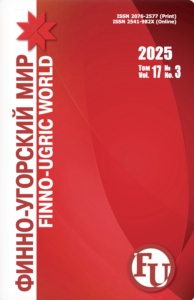SPECIAL FEATURES
Interview with the Chairperson of the State Committee of the Mordovia Republic on National Policies A. S. LUZGIN
Resolution IV Congress of Finno-Ugric Peoples of Russia
LANGUAGE PALETTE
Y. A. TAMBOVTSEV (Novosibirsk, Russia). Euphony of the Sound Chain in the Finno-Ugric Languages
The article analyzes the sound chain in the Finno-Ugric languages in relation to the degree of euphony. It compares the degree of sound chain euphony in the Finno-Ugric, Turkic, Slavic, and some other languages.
L. A. ANDREEVA (Khanty-Mansiysk, Russia). Functions of Possessive Suffixes in Case of –ash Infinitives in the Mari Language
In the Mari language possessive suffixes can be used not only with nouns, but also with other parts of speech, with the verb in particular. The author discusses the functions of the possessive suffix in case of –ash infinitives
S. HEINONEN (Joensuu, Finland), O. G. BORISOVA (Saransk, Russia). Observations on Ekphrasis in the Novel M. Fagerholm «Diva»
It analyzes ekphrasis type of narration in the novel of contemporary Finnish writer Monika Fagerholm «Diva».
CLOSE–UP
N. S. RUZANKINA (Saransk, Russia). Came Down from Heaven
OUR SHARED HISTORY
N. F. MOKSHIN (Saransk, Russia). The Origin of the Finno-Ugric (Uralic) Peoples
It reviews the problem of the origin of the Finno-Ugric (Uralic) peoples from modern academic point of view. It notes that even though the majority of these peoples is still archaeogenetic, they have retained not only their own Uralic ethnic identity, but also many features of the material and spiritual culture.
IT IS INTERESTING
A. M. DORONIN (Saransk, Russia). We Are of Common. Speech at the Official Meeting Dedicated to the 75-th Anniversary of the Writers’ Union of Mordovia, September 18, 2009
TREASURY OF TRADITIONAL CULTURE
O. G. BELOMOEVA (Saransk, Russia). Ethno-cultural Traditions in the Context of Contemporary Artistic Practices
It analysis modern cultural strategies of positioning local culture within the global cultural space. It characterizes one of the major trends in the artistic culture – ethnofuturism considered upon the example of painting artists of Mordovia and Mari-El.
G. A. KORNISHINA (Saransk, Russia). Functions of Symbols and Symbolic Categories of Clothes in Traditional Mordovia Wedding Cycle
The article deals with traditional Mordovian clothing as an important component of folk customs and ceremonies, including weddings. It shows the symbolic value and functions of its individual components.
PROSPECTS
J. PUSZTAY (Szombathely, Hungary). Finno-Ugric Organizations in Hungary
Interview with the Director of Fenno-Ugria Asutus V.-K. RAUDALAINEN (Tallinn, Estonia )
M. HANNUS (Helsinki, Finland). Organization «Finland – Russia» – a Civil Figure in the Area of Developing the Relations with Russia
FINNO-UGRIC PEOPLES IN CHANGING WORLD
O. A. BOGATOVA (Saransk, Russia). Ethno-cultural Identity and Religious Practices of the Population of Mordovia
The article analyzes ethnic, cultural and religious components of ethnic identity of the most numerous ethnic groups of the population of the Republic of Mordovia. It emphasizes the level of religiosity of the population of the Republic in terms of the ratio of confessional identity as ethnic and cultural character and true religious practices of Christian Orthodox believers.
J. VALGE (Tartu, Estonia). Higher Education in the Mother Tongue as the Essential Condition to Preserve the Language
The article considers higher education in the mother tongue as the essential factor in preserving the language. It assesses the current state and prospects of the Estonian language in Estonian Universities, and discusses the measures to promote and protect the language.
EVENTS, PEOPLE, BOOKS
O. M. SUSOREVA (Saransk, Russia). Ethnic Minorities in Russia: Development of Language, Culture, Media and Civil Society
M. V. MEDVEDEVA (Moscow, Russia). Monograph review: L.B. Boyarkina Folk Songs in the Interpretation of Illarion Yaushev
V. B. MAKHAEV (Saransk, Russia). The Universe of Stepan Erzya. Book review: Facets of the sculptural universe: works of Stepan Erzya in Saransk museums






















